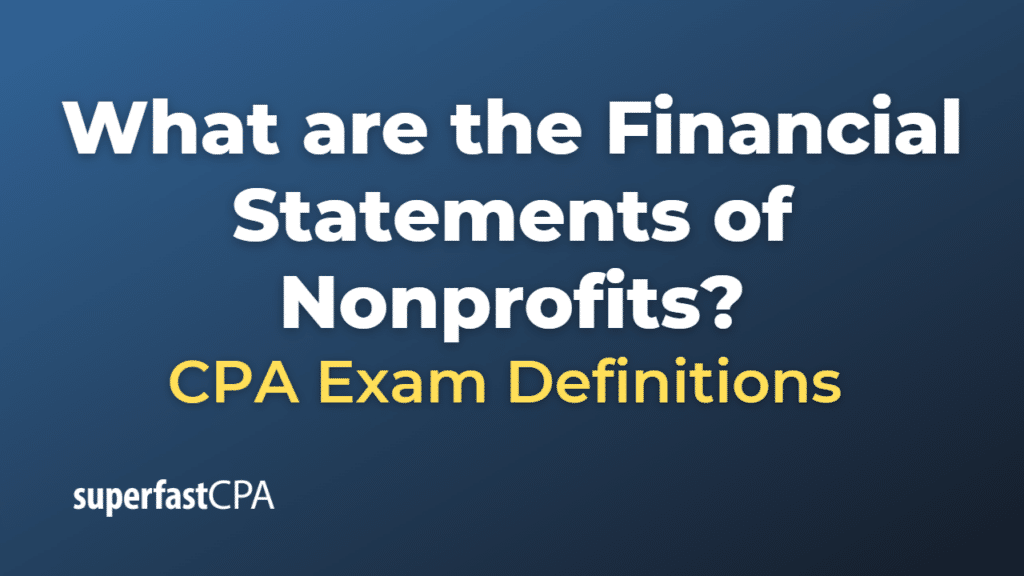Financial Statements of Nonprofits
Nonprofit organizations also prepare financial statements to communicate their financial activities to stakeholders, although these statements may have different names and formats compared to those of for-profit entities due to the different nature of their operations. Here are the typical financial statements prepared by nonprofits:
- Statement of Financial Position: This is equivalent to the balance sheet in a for-profit company. It lists the nonprofit’s total assets, liabilities, and net assets at a specific point in time. Unlike a for-profit company, a nonprofit organization does not have owners, so instead of shareholders’ equity, we have net assets, which are further divided into “without donor restrictions” and “with donor restrictions” based on the nature of the donations and funds received.
- Statement of Activities: This is similar to the income statement of a for-profit company but instead of revenues, costs, and profits, it reports the revenues (without donor restrictions and with donor restrictions), expenses, and changes in net assets during a period. Revenue for nonprofits usually comes from donations, grants, and membership dues, while expenses could include program services expenses and supporting services expenses.
- Statement of Cash Flows: Similar to a for-profit company, this statement shows the cash inflows and outflows from operating, investing, and financing activities over a period. However, the details may be different because nonprofit organizations don’t typically have investing and financing activities in the same sense as a for-profit business.
- Statement of Functional Expenses: This is unique to nonprofit organizations. It provides a detailed breakdown of expenses by both function (i.e., program services, general and administrative, and fundraising) and nature (i.e., salaries, rent, supplies, etc.). This allows stakeholders to see how the nonprofit is allocating its resources.
These statements are usually accompanied by footnotes and other disclosures that provide additional information about the organization’s financial activities. The financial statements of nonprofit organizations are prepared in accordance with the Financial Accounting Standards Board (FASB) guidelines in the United States or other applicable accounting standards in other jurisdictions.
Example of the Financial Statements of Nonprofits
Let’s take an example of a fictional nonprofit organization called “Helping Hands”. The organization receives funds through donations and uses these funds to run community programs. Below are simplified examples of their financial statements.
- Statement of Financial Position (as of December 31, 2023)
Assets
- Cash: $60,000
- Property, Plant, and Equipment (net): $150,000
- Total Assets: $210,000
Liabilities
- Accounts Payable: $20,000
- Total Liabilities: $20,000
Net Assets
- Net Assets without Donor Restrictions: $100,000
- Net Assets with Donor Restrictions: $90,000
- Total Net Assets: $190,000
- Statement of Activities (for the year ended December 31, 2023)
Revenues
- Donations without Donor Restrictions: $100,000
- Donations with Donor Restrictions: $90,000
- Total Revenues: $190,000
Expenses
- Program Services: $100,000
- General and Administrative: $30,000
- Fundraising: $20,000
- Total Expenses: $150,000
- Increase in Net Assets: $40,000
- Statement of Cash Flows (for the year ended December 31, 2023)
Cash from Operating Activities
- Increase in Net Assets: $40,000
- Depreciation: $10,000
- Total Cash from Operating Activities: $50,000
Cash from Investing Activities
- Capital Expenditures: -$20,000
- Total Cash from Investing Activities: -$20,000
Net Increase in Cash: $30,000
- Statement of Functional Expenses (for the year ended December 31, 2023)
- Salaries (Program Services): $60,000
- Salaries (General and Administrative): $20,000
- Salaries (Fundraising): $10,000
- Rent (Program Services): $20,000
- Rent (General and Administrative): $5,000
- Rent (Fundraising): $5,000
- Office Supplies (Program Services): $10,000
- Office Supplies (General and Administrative): $3,000
- Office Supplies (Fundraising): $2,000
Total Expenses: $150,000
These are highly simplified examples. Real-world nonprofit financial statements are usually much more complex and contain more line items, additional schedules, and footnotes explaining the numbers.













